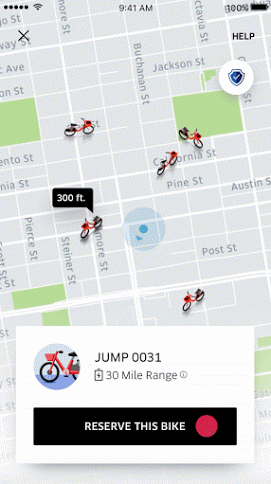
Changing the Way People Move in Their Cities Though Bikes
Dockless electric-assist bike rentals powered by the Uber App
STAKEHOLDER UBER
THE CHALLENGE
Design a 0-1 bike pilot experience within the Uber app to see is riders would be willing to offset their short distance trips with bikes instead of cars.
THE OUTCOME
Bike's were quickly adopted for their ability to better service transportation needs during the first and last mile portions of a users rush hour commute than would've been possible with carshare alternatives like UberPool and UberX
IMPACT
With the pilot's success we've proved out the multi-mobility concept for Uber, received a lot of positive attention from new sources, and would subsequently purchase Jump for $200 million (Apr 2018). By May 2019, Uber Bike would expand to 24 domestic and international cities where the average trips per week was estimated to be 3.5 million.
MY ROLE
Junior designer supporting a team of 3 responsible for the entire Uber Bike experience.
Additional responsibilities: Conducting user research, stakeholder management (Jump + Uber), requirements gathering, 3D modeling, UX design, visual design, and rapid prototyping

INTRODUCTION
45% of all car trips in the US are < 3 miles. Arguably, that number could be a lot lower if people had access to better, more affordable transportation alternatives. And while Uber has grown its business by providing more ways for people to get around, it has fallen short when it comes to consistently serving the #1 transportation use case—a person's commute!
In order to help solve this problem, Uber teamed up with the bike share company Jump. The goal of the partnership was to see if riders would be willing to offset their short distance trips with dockless electric-assist bicycles.
BACKGROUND
Cities for the longest time have had limited transportation options for commuters. For many, the solution is driving, taking public transportation, riding a bicycle, or taking ride share. But even then there is no clear winner and each mode presents its own pain points. As one research participant said, “Owning a car in the city is so expensive, but the bus takes a really long time and is unpleasant…I don’t own a bicycle because I’ll get to work sweaty and it might get stolen.”
Owning a car in the city is so expensive, but the bus takes a really long time and is unpleasant…I don’t own a bicycle because I’ll get to work sweaty and it might get stolen.


BECOMING BIKE EXPERTS
So how did we get from “let’s put bikes into the app” to grossing over 3.5 million daily trips in less than 2 years? Well to be honest, it began with just a couple humble storyboards.
Our team of 5 became the domain experts on bikes—at a ride share company no less—and utilized the power of storyboarding to build empathy with our users. Included in our pitch deck were only the most critical bike use cases: the commuter, running an errand, and the weekend warrior. Each highlighted a different way in which we foresaw the product being used and allowed us to build a convincing case for bikes. Then, at key points in the development process we strategically looped in stakeholders from external teams and used the story boards to ground the conversation and not lose sight of our user’s needs.








ENGINEERING JUMP INTO UBER
Adding a whole new product into the Uber app was difficult enough, but having two companies' engineering team weigh in on the process made things especially challenging for design. On the Uber side, we made compromises with the rider team and found a temporary home for the bike experience nested within within the hamburger menu. And on the Jump side we had to build in compliance with their state machine for reserving a bike; which meant we couldn't suggest adding QR scanning—at least not yet.
But given all that, we put together the best possible experience given the constraints to prove our hypothesis true. People did in fact want bikes! And upon launch, the overwhelming positive feedback we received would eventually help our team build a case to get more resources and internal support.





RESULTS
In the end, we produced a successful minimum viable product (MVP) that received a lot of positive attention, proved out the multi-mobility concept for Uber, and resulted in Uber purchasing Jump in order to double down on it’s bike offering.
-
In Feb 2018, JUMP averaged 4 trips per bike per day in San Francisco
-
JUMP trips receive over 98% parking satisfaction – meaning that less than 2% of all trips taken with JUMP result in a parking complaint
-
Average trip distance: 2.6 miles
-
In Apr 2018, Uber would acquire Jump for 200 Million

PRESS
FEATURED IN




